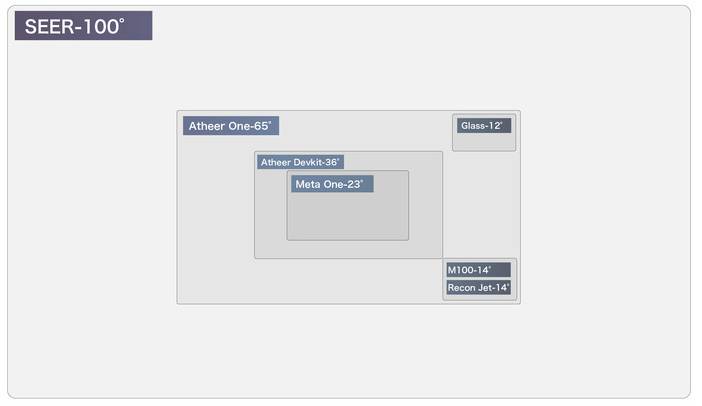Augmented reality headsets either try to be very subtle in appearance, as in the sunglasses styles, or try to provide a superior optical performance without looking at the aesthetic consequences. In this group are the fighter pilot helmets, for example. The new Seer headset also falls into this latter category.
The Seer headset by Caputer labs Inc. is also the type that does not come with its own display but instead uses the screen of the users smartphone as the display of choice. From a cost standpoint this approach promises much lower cost headsets and the Seer is no exception; so far the estimated price is around $119.
Several solutions exist for virtual headsets using smartphones, ranging from cardboard boxes to more sophisticated carriers. Augmented reality in such devices is provided by a camera overlaying the real world to the augmented reality information on the screen. The smartphone is typically located directly in front of the user’s eyes. This approach requires two lenses, one for each eye. In addition, making the headset as thin as possible creates an optical path that is very short, limiting the achievable field of vision. On the other hand the independent nature of the optical path is ideal to provide 3D images with basically no crosstalk. However, this also limits the resolution per eye to less than half of the smartphone’s resolution.
The Seer headset on the other hand takes a different approach. The smartphone is located on top of the head facing forward and being reflected from the visor back to the user’s eyes. The following image compares this design with that of a very expensive augmented reality headset for fighter jet pilots.
Source: Seer
The difference in price is also reflected in the amount of optical components in the Seer design and ultimately, we expect, in the image quality, including brightness. In addition, since the whole display is used to project on the visor, the full resolution of the smartphone can be experienced by both eyes. As a consequence, you lose the ability to provide 3D imagery.
From the standpoint of the user, one important aspect of any virtual or augmented reality headset is the achieved field of vision. In recent iterations of the AR and VR hardware, the FoV is more and more of a selling point. Based on this design Seer achieves a very high value for the FoV with 100 degrees in the diagonal. With fixed optics, the FoV is dependent on the smartphone display size and the 100 degrees is reached with a 6″ smartphone or phablet.
 Source: Seer
Source: Seer
The difference is quite impressive indeed.
The difference between an augmented and a virtual reality headset depends on the ability, or not, to see through the real life in front of the user. Since the Seer uses a semi transparent reflector it basically qualifies as an augmented reality headset. The forward vision can be affected by a dark visor that will turn the headset into a virtual reality headset.
Overall, the headset is little larger than other “smartphone insert” types, but the weight distribution may be preferable as the smartphone is more on top of the head instead of in front.
Caputer is now in crowdfunding mode, with a Kickstarter campaign aiming to raise $100,000, which the company almost achieved in the first two weeks. According to its timeline, mass production will start in July 2015 and shipments will commence in September. – NH

